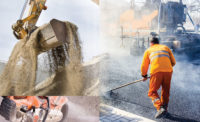 Yes, respirators will be the primary PPE discussed when protecting workers against silica dust exposures. Silica dust often arises when workers are cutting, crushing, drilling, grinding or otherwise disturbing material that might loosen silica, particularly in construction and mining work. That kind of work – cutting into concrete, brick and block, stone and rock, masonry and tile – very often requires goggles or safety eyewear with side shields to protect eyes from flying particles. Also hearing protection in many cases will be required due to high noise levels.
Yes, respirators will be the primary PPE discussed when protecting workers against silica dust exposures. Silica dust often arises when workers are cutting, crushing, drilling, grinding or otherwise disturbing material that might loosen silica, particularly in construction and mining work. That kind of work – cutting into concrete, brick and block, stone and rock, masonry and tile – very often requires goggles or safety eyewear with side shields to protect eyes from flying particles. Also hearing protection in many cases will be required due to high noise levels.
OSHA is proposing two new silica standards: one for general industry and the maritime industry, and one specifically for construction.
OSHA estimates that about 2.2 million workers in the U.S. are exposed to silica dust – nearly 1.85 million of whom are in the construction industry – and potentially face silica-related disease. In addition to causing silicosis, studies also have found a strong association between silica exposure and lung cancer, kidney disease and autoimmune system disorders.
The rule lowers the legal limit of silica dust that workers are permitted to breathe to 50 micrograms of respirable silica per cubic meter of air, and for construction workers, suggests specific control methods, such as wet cutting and ventilation in certain situations.
The proposed rule also includes provisions for measuring how much silica workers are exposed to, limiting workers’ access to areas where silica exposures are high, using effective methods for reducing exposures, providing medical exams to workers with high silica exposures, and training for workers about silica-related hazards and how to limit exposure.
OSHA estimates that the proposed rule will save nearly 700 lives and prevent 1,600.
OSHA has been trying to strengthen rules limiting workers' exposure to silica since the 1980s, but has been stymied by industry opposition. Its current proposal had been mired in bureaucratic limbo since 2000. Most recently, it was stuck at the U.S. Office of Management and Budget’s Office of Information and Regulatory Affairs (OIRA) for more than two and a half years, despite the agency’s deadline to review the rule within 90 days.
For more information on OSHA’s proposed silica rule, visit: www.osha.gov/silica/index.html.



